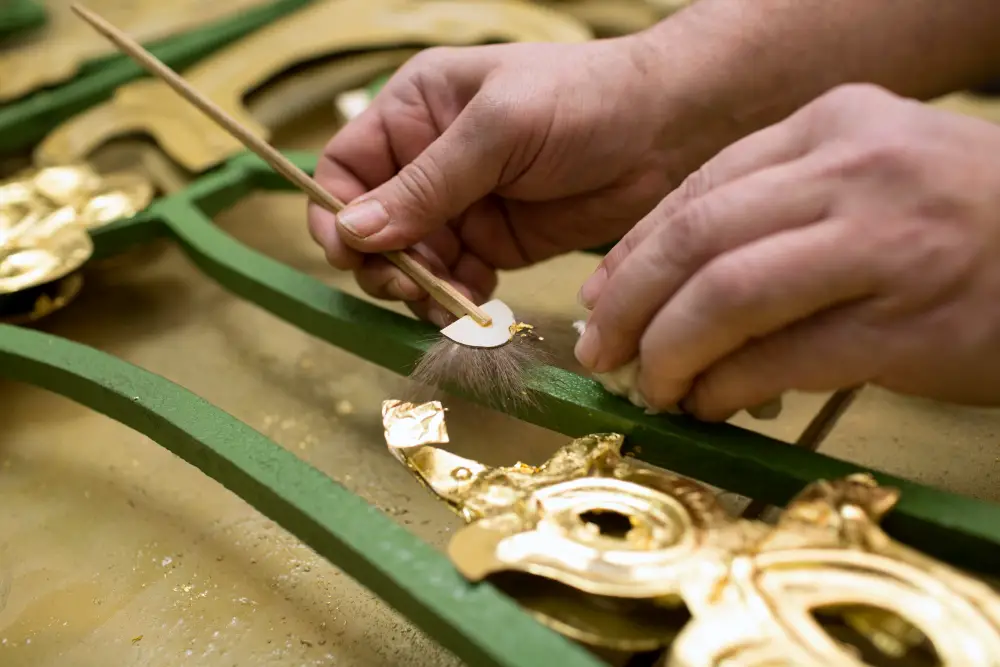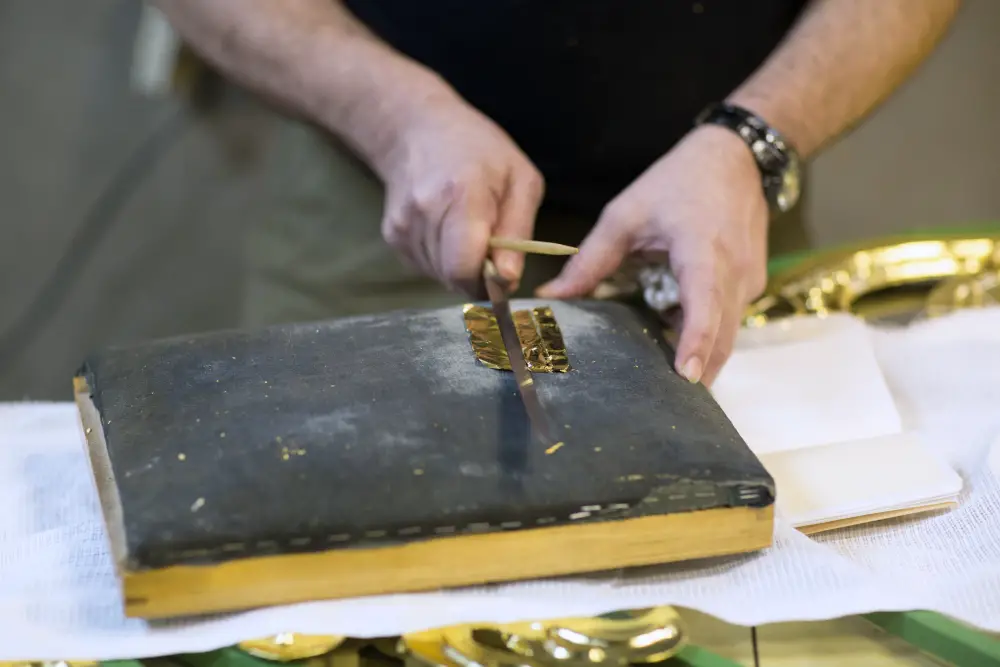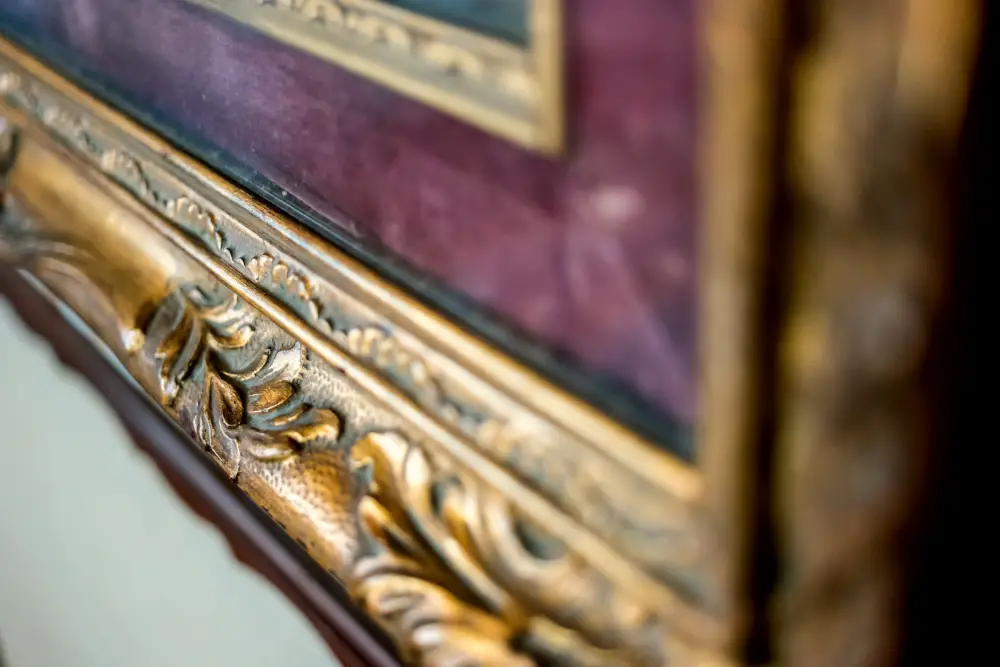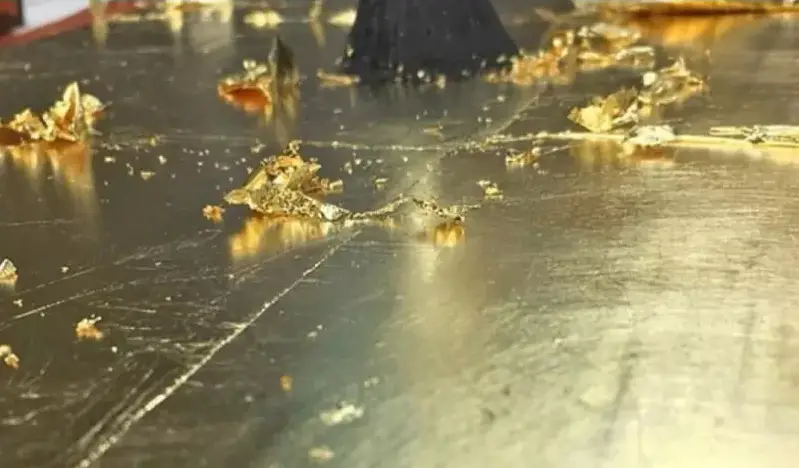Gilding is one of the most spectacular finishing methods by which wood can be transformed into exquisite luxury objects. Thus, wooden furniture, picture frames and mirrors rise in value and enter a higher category of elegance and refinement when carefully covered with gold leaf or quality products that imitate this effect. Various gilding techniques, some of which have been used for centuries, produce objects that are considered true works of art. Objects decorated with gilding were once used to show the social status of the owner and adorned castles and palaces. Nowadays, gilding is used to repair and restore old objects that have been worn down by the passage of time, but also to add lustre and elegance to special projects.
The subject of "gilding wood" is very rich and impossible to cover in a single article. In order to be able to provide all the information related to this subject, we propose to present in the following an overview of the gilding process, and then come back with separate articles on topics of interest such as: gold leaf and other metals for finishing, special adhesives, primers, necessary tools, etc. In the article you will also discover the range of gilding materials Borma Wachsprovided by Loma Tech.

Gilding furniture - Refinement and social status
In the past, the gilding technique was masterfully used to create exclusive pieces of furniture for the palaces and castles of the nobility. They were not mere objects of utility, but true works of art, showing the wealth, power and refinement of a privileged social class. Chairs, tables and chests of drawers were exquisitely crafted using gold, the ultimate symbol of wealth, applied to carefully carved wood.
Craftsmen and artisans specialising in gilding used traditional techniques to turn furniture and other objects into works of art. Gilded furniture in palaces and castles was a symbol of family power and prestige and was often accompanied by hand-woven carpets, tapestries embroidered with gold thread and fine porcelain, creating an atmosphere of refinement to opulence.
However, gilding is not a technique reserved for the past, as gilded objects, made with craftsmanship, are distinguished by a timeless elegance. True, restoration specialists use gilding techniques to repair and save valuable old objects, but decorating with gold-based or gold-mimicking materials can also be used successfully for contemporary projects.
Materials and techniques used in wood gilding
Whether using the classic material or experimenting with an alternative material, the selection of products to work with is essential to achieve the desired result.
Gold leaf - the classic gilding material
Classical gilding is done with gold leaf. It takes specialist knowledge and skill to create a truly remarkable object. The surface of the wood must be prepared beforehand to ensure the gold has the necessary adhesion. This preparation involves several steps: cleaning, sanding and sometimes applying a special primer. Once the surface is prepared, a special glue is applied to fix the gold leaf. This step requires a lot of skill and care to avoid the sheet forming creases or air bubbles underneath. Special tools such as leather brushes, soft brushes or squirrel hair brushes are used to make the transfer of the leaf easy and to fix it correctly. Then leave it to dry thoroughly. Finally, gently brush off the excess sheet with a soft brush.
Shlagmetal - alternative material for gilding furniture
Being 24 carat gold, gold leaf is not a cheap material. Those who are just starting out or those who want a similar effect can use shlagmetal, an alloy of copper and zinc that imitates the shine of gold very well. It is a much more affordable alternative that also comes in sheet form and is applied in the same way as gold leaf, to a clean and carefully prepared surface. Finally, after drying and removing excess leaf, varnish is applied for protection and high gloss. Unlike gold leaf, shlagmetal leaf changes colour slightly over time, taking on a slight reddish tint.
A somewhat gilt-like appearance can be achieved with metallic paints or patinas coloured gold or bronze. These are materials that have nothing in common with the classical technique of applying gold leaf, nor with gold. They are, however, much cheaper and easier to use. They are generally used in industrial production, for mass-produced furniture with special effects or in DIY projects. The appearance is not as fine as that of sheet, but it can satisfy the less demanding requirements of the general public. These alternatives to gold leaf are not, however, acceptable options for the repair and restoration of antique furniture and objects.

Which wood is suitable for gilding
Virtually any type of wood can be gilded. But that doesn't mean we want to cover a wood with a special design, such as a walnut root or a peacock's eye, with gold or imitation gold. The most suitable species are those with a straight, even grain that can be carved or turned easily. Lime, poplar, birch are such species. By applying the gilding technique, their value is enhanced and they are given a distinctive elegance.
Given the fine and elegant look of the gilding, one would be tempted to think that large-pored wood should not be used. But experts say that the effect of gilding is very interesting on oak. In England during the Victorian period (1860s), the artist George Frederick Watts applied gold to the oak frames for his paintings, so that the pores and even the grain of the oak remained visible through the fine poignard. It was an innovation that created a new aesthetic trend in gilding and framing. Until then decorative patterns had been used under the gold leaf, but never the natural design of the wood.
Gilding has the advantage that it covers the substrate to which it is applied, greatly increasing its value and appearance. This is why some manufacturers of picture and mirror frames have chosen to use plywood and MDF to make them. After mechanically processing the plywood or MDF, the surface is thoroughly cleaned, sanded and primed, providing the perfect backing for the application of gold leaf. In this way, materials considered below the level of solid wood are ennobled by the precious metal, their value increasing exponentially.

Gilding with Borma Wachs materials
Online platform bormaromania.ro, offers a wide range of Borma Wachs gilding products as well as advice and support from Loma Tech specialists. From gold leaf, powder and liquid solution, to shlagmetal, bases, glues and application tools, everything can be found in section dedicated to gilding.
24 carat gold foil from Borma Wachs is one of the purest and most valuable materials used in decorative finishes and art restorations. Because of its purity, 24-carat gold offers outstanding brilliance and reflection. It is a versatile and durable material that resists oxidation and corrosion. Very good results are achieved if the surface is smooth and clean and special gilding adhesives are used. It also requires special tools such as leather cushion, knife for cutting the sheet, squirrel hair brush and agate stones for polishing the sheet. A short video demonstration of how to apply gold leaf to the backing can be seen here.
For small repairs of gilded objects you can use 23.75 carat water-soluble gold powder. It is a mixture of gum arabic and gold powder with which gold surfaces can be retouched. The formula allows easy and effective application of gold to various surfaces, the finish matching the appearance of the original gold leaf perfectly. It is the perfect product for restoring worn and damaged areas of various objects and is easy to prepare and apply. After application, the surface is allowed to dry completely until the gum arabic is no longer tacky. It is then polished with agate stone.
Shlagmetal imitation gold leaf made from pure metal alloys, is versatile and can be applied to materials such as wood, glass, metal, ceramic or plastic. It is the ideal solution for artists, interior designers and restorers, as the sheets can be used to restore old furniture, art objects or architectural details. The imitation gold sheet is also compatible with printing inks and can be used for graphic design and product packaging. To apply imitation gold leaf, first prepare the substrate with a layer of white acrylic primerAfter 4-6 hours, which is the drying time, apply a coat of water-based adhesive or oil-based. After another 4-6 hours, the solvent will evaporate and the surface will remain tacky. On this surface, place the sheet, which is removed with a paper spatula. If it does not adhere perfectly, press with a cotton pad. Allow 6-8 hours for complete adhesion, then remove the excess with a soft brush. Finally apply a coat of lake for a brilliant look.

Gilding materials and techniques remain a permanent mark of refinement and luxury. From the use of gold leaf and shlagmetal in the restoration of antique furniture to the creation of exceptional contemporary pieces, these techniques and materials continue to impress and inspire. Over time, gilding has evolved to adapt to contemporary needs and preferences. Techniques have diversified and the range of materials has grown and can be used in a wide variety of fields, from interior design and crafts to architecture and contemporary art.






























Add comment